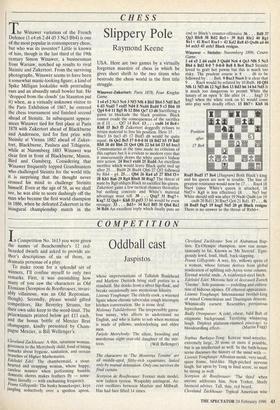CHESS
Slippery Pole
Raymond Keene
he Winawer variation of the French Defence (1 e4 e6 2 d4 d5 3 Nc3 Bb4) is one of the most popular in contemporary chess, but who was its inventor? Little is known of him, though in the last third of the 19th century Simon Winawer, a businessman from Warsaw, notched up results to rival Steinitz and Zukertort. From the surviving photographs, Winawer seems to have been a somewhat manic-looking figure; a kind of Spike Milligan lookalike with protruding ears and an absurdly small bowler hat. He 'dropped from the clouds' (as Staunton put it) when, as a virtually unknown visitor to the Paris Exhibition of 1867, he entered the chess tournament and finished second ahead of Steinitz. In subsequent appear- ances Winawer tied for first place at Paris 1878 with Zukertort ahead of Blackburne and Andersson, tied for first prize with Steinitz at Vienna 1882 ahead of Zuker- tort, Blackburne, Paulsen and Tchigorin, while at Nuremberg 1883 Winawer was clear first in front of Blackburne, Mason, Bird and, Gunsberg. Considering •that Winawer frequently topped Grandmasters who challenged Steinitz for the world title it is surprising that the thought never
crossed his mind to challenge Steinitz•himself. Even at the age of 58, as we shall
see, he was able to score dashingly off the Man who became the first world champion in 1886, when he defeated Zukertort in the inaugural championship match in the USA. Here are two games by a virtually forgotten maestro of chess in which he gives short shrift to the two titans who bestrode the chess world in the first title struggle.
Winawer-Zukertort: Paris 1878; Four Knights Game.
1 e4 e5 2 Nc3 Nc6 3 Nf3 Nf6 4 Bb5 Bb4 5 Nd5 Bc5 6 d3 Nxd5 7 exd5 Nd4 8 Nxd4 Bxd4 9 c3 Bb6 10 Qg4 0-0 11 Bg5 f6 12 Bh6 Qe7 13 d6 Sacrificing a pawn to blockade the black position. Black cannot evade the consequences of the sacrifice as if 13 . . . Qf7 14 Bc4. 13 . . . cxd6 14 Bc4+ Kh8 15 Be3 15 Zukertort doggedly_ refuses to return material to free his position. Here 15 . . Bxe3 16 fxe3 d5 17 Bxd5 d6 would be quite equal. 16 Qe2 Bc5 17 0-0-0 f4 18 Bd2 b5 19 Bd5 Rb8 20 d4 Bb6 21 Qe4 Q16 22 h4 b4 23 h5 bxc3 Commentaries at the time made no criticism of this capture but it is evident to modern eyes that it unnecessarily draws the white queen's bishop into action. 24 Bxc3 exd4 25 Rxd4 An excellent sacrifice which would leave Black quite tied up after 25... Bxd4 26 Bxd4 Qh6 27 01f3 followed by Rh4 – g4. 25... Qh6 26 Ra4 a5 27 Rh4 13+ 28 Kbl Bab 29 Rg4 Rbe8 30 Rxg7 The threat of mate by Rg8 obliges Black to sacrifice his queen. Zukertort gains a few tactical chances thereafter but nothing concrete and White's material advantage must tell. 30. . . Qxg7 31 Bxg7+ Kxg7 32 Qg4+ Kh8 33 gxf3 33 h6 would be even stronger. 33 . . . Bd3+ 34 Kcl Bf5 35 Qh4 Re2 36 Rd4 An excellent reply which finally puts an end to Black's counter-offensive 36 . . . Bd8 37 Qg3 R1e8 38 Rd2 Rel + 39 Rdl R1e2 40 Rgl Rel+ 41 Rxel Rxel+ 42 Kd2 Re8 43 Qxd6 a4 44 b4 axb3 45 axb3 Black resigns.
Winawer – Steinitz: Nuremberg 1896; Centre Game.
1 e4 e5 2 d4 exd4 3 Qxd4 Nc6 4 Qe3 Nf6 5 Nc3 Bb4 6 Bd2 0-0 7 0-0-0 Re8 8 Bc4 Bxc3 Steinitz loved to grab hot pawns but this is much too risky. The prudent course is 8 . . . d6 to be followed by , . . Be6, 9 Bxc3 Nxe4 It is clear that 9.. . Rxe4 would be refuted by 10 Bxf6. 10 Qf4 Nf611 N13 d6 12 Ng5 Be6 13 Bd3 h6 14 h4 Nd.5 It is much too dangerous to permit White the luxury of an open 'h' file after 14 . . . hxg5 15 hxg5 when the white rook on hl would come into play with deadly effect. 15 Bh7+ Kh8 16
Position after 17 Be4 Rxd5 Bxd5 17 Be4 (Diagram) Both Black's king and his queen are now in trouble. The line of greatest resistance would now be 17. . . Rxe4 18 Nxe4 (since White's queen is attacked, 18 Nxf7+ Kg8 is less effective) 18 . . . Ne5 but White should still win after 19 Nxd6 Qxd6 (or 19 . . . cxd6 20 Rdl) 20 Bxe5 Qc6 21 Rdl. 17 . . .f6 18 Bxd5 fxg5 19 hxg5 Ne5 20 g6 Black resigns There is no answer to the threat of Rxh6+.


















































 Previous page
Previous page